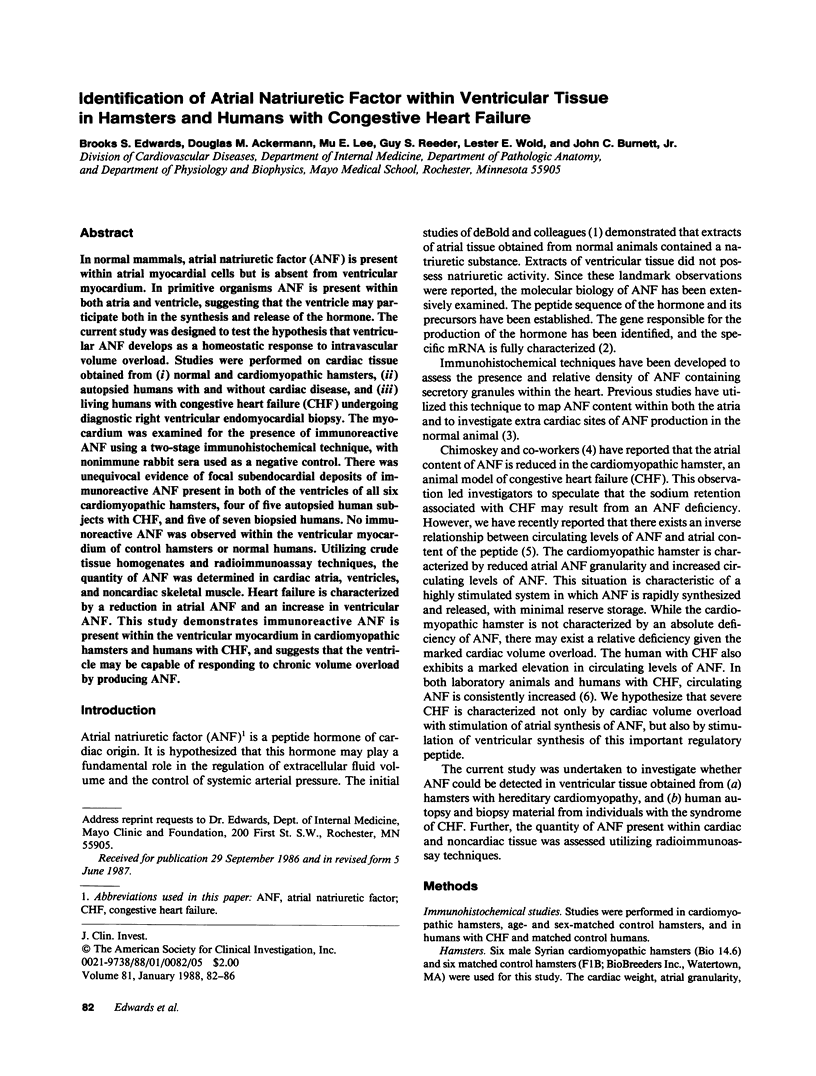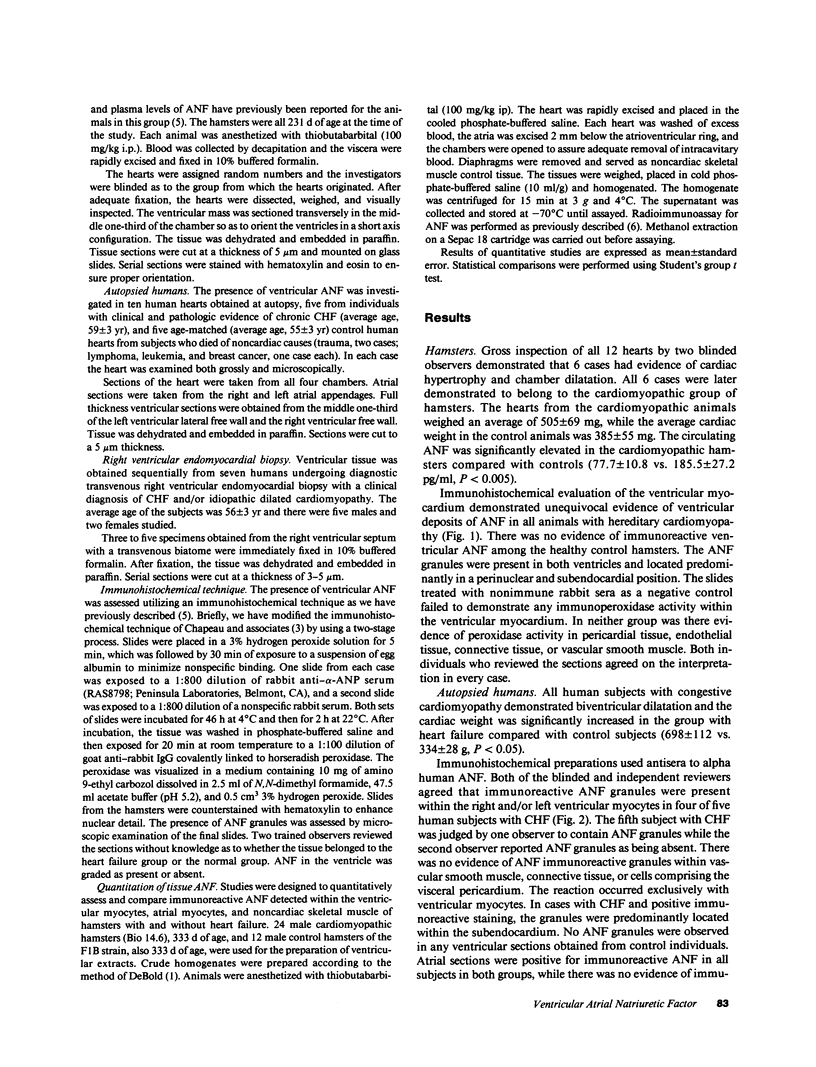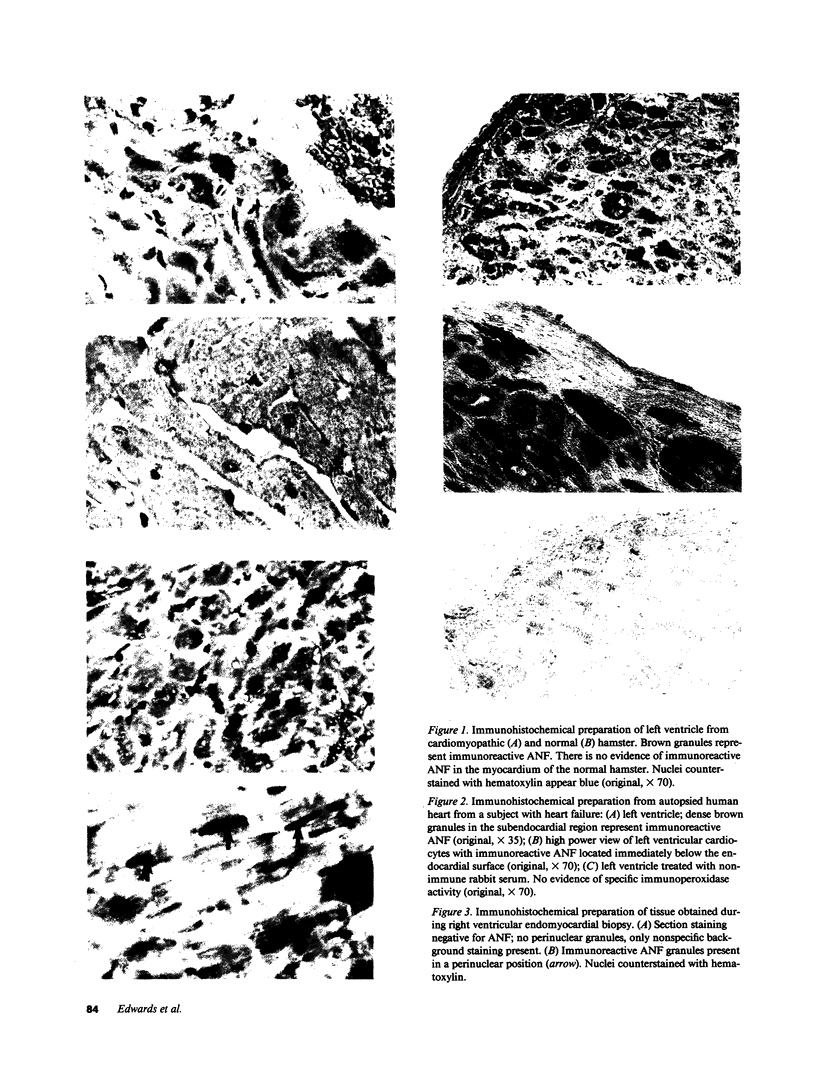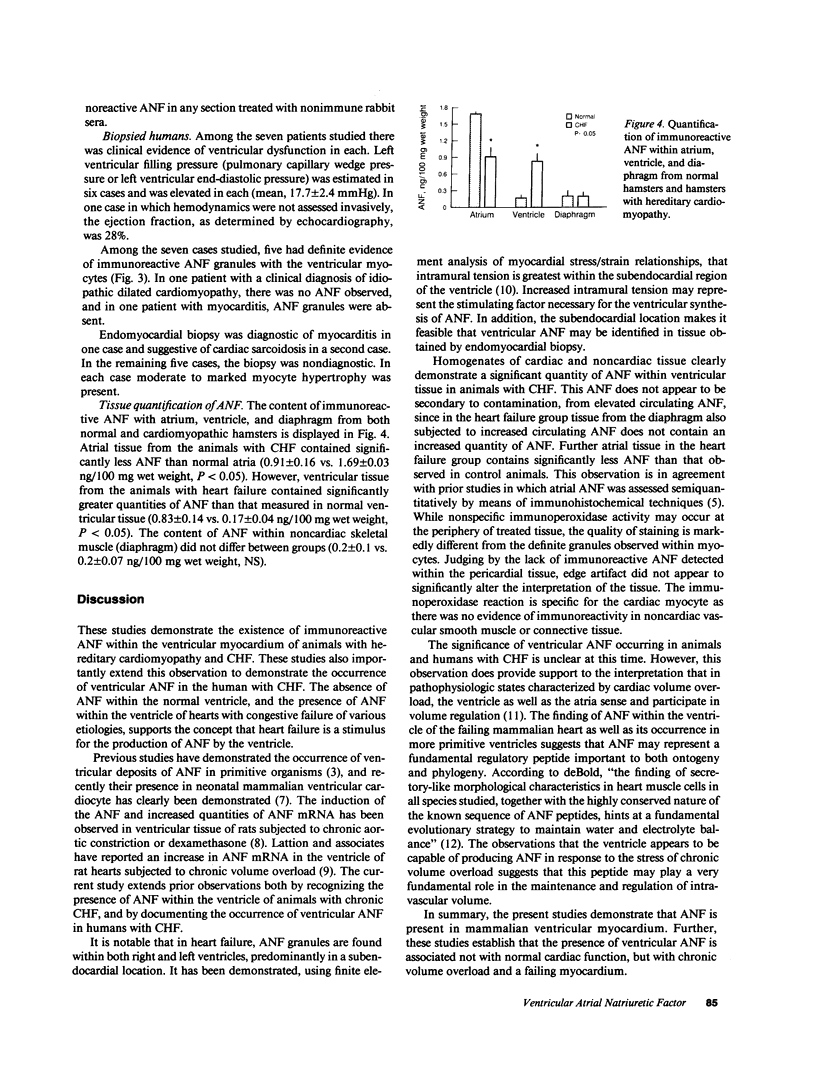Abstract
In normal mammals, atrial natriuretic factor (ANF) is present within atrial myocardial cells but is absent from ventricular myocardium. In primitive organisms ANF is present within both atria and ventricle, suggesting that the ventricle may participate both in the synthesis and release of the hormone. The current study was designed to test the hypothesis that ventricular ANF develops as a homeostatic response to intravascular volume overload. Studies were performed on cardiac tissue obtained from (i) normal and cardiomyopathic hamsters, (ii) autopsied humans with and without cardiac disease, and (iii) living humans with congestive heart failure (CHF) undergoing diagnostic right ventricular endomyocardial biopsy. The myocardium was examined for the presence of immunoreactive ANF using a two-stage immunohistochemical technique, with nonimmune rabbit sera used as a negative control. There was unequivocal evidence of focal subendocardial deposits of immunoreactive ANF present in both of the ventricles of all six cardiomyopathic hamsters, four of five autopsied human subjects with CHF, and five of seven biopsied humans. No immunoreactive ANF was observed within the ventricular myocardium of control hamsters or normal humans. Utilizing crude tissue homogenates and radioimmunoassay techniques, the quantity of ANF was determined in cardiac atria, ventricles, and noncardiac skeletal muscle. Heart failure is characterized by a reduction in atrial ANF and an increase in ventricular ANF. This study demonstrates immunoreactive ANF is present within the ventricular myocardium in cardiomyopathic hamsters and humans with CHF, and suggests that the ventricle may be capable of responding to chronic volume overload by producing ANF.
Full text
PDF




Images in this article
Selected References
These references are in PubMed. This may not be the complete list of references from this article.
- Ballermann B. J., Brenner B. M. George E. Brown memorial lecture. Role of atrial peptides in body fluid homeostasis. Circ Res. 1986 May;58(5):619–630. doi: 10.1161/01.res.58.5.619. [DOI] [PubMed] [Google Scholar]
- Bloch K. D., Seidman J. G., Naftilan J. D., Fallon J. T., Seidman C. E. Neonatal atria and ventricles secrete atrial natriuretic factor via tissue-specific secretory pathways. Cell. 1986 Dec 5;47(5):695–702. doi: 10.1016/0092-8674(86)90512-x. [DOI] [PubMed] [Google Scholar]
- Burnett J. C., Jr, Kao P. C., Hu D. C., Heser D. W., Heublein D., Granger J. P., Opgenorth T. J., Reeder G. S. Atrial natriuretic peptide elevation in congestive heart failure in the human. Science. 1986 Mar 7;231(4742):1145–1147. doi: 10.1126/science.2935937. [DOI] [PubMed] [Google Scholar]
- Chapeau C., Gutkowska J., Schiller P. W., Milne R. W., Thibault G., Garcia R., Genest J., Cantin M. Localization of immunoreactive synthetic atrial natriuretic factor (ANF) in the heart of various animal species. J Histochem Cytochem. 1985 Jun;33(6):541–550. doi: 10.1177/33.6.3158698. [DOI] [PubMed] [Google Scholar]
- Chimoskey J. E., Spielman W. S., Brandt M. A., Heidemann S. R. Cardiac atria of BIO 14.6 hamsters are deficient in natriuretic factor. Science. 1984 Feb 24;223(4638):820–822. doi: 10.1126/science.6538050. [DOI] [PubMed] [Google Scholar]
- Day M. L., Schwartz D., Wiegand R. C., Stockman P. T., Brunnert S. R., Tolunay H. E., Currie M. G., Standaert D. G., Needleman P. Ventricular atriopeptin. Unmasking of messenger RNA and peptide synthesis by hypertrophy or dexamethasone. Hypertension. 1987 May;9(5):485–491. doi: 10.1161/01.hyp.9.5.485. [DOI] [PubMed] [Google Scholar]
- Edwards B. S., Ackermann D. M., Schwab T. R., Heublein D. M., Edwards W. D., Wold L. E., Burnett J. C., Jr The relationship between atrial granularity and circulating atrial natriuretic peptide in hamsters with congestive heart failure. Mayo Clin Proc. 1986 Jul;61(7):517–521. doi: 10.1016/s0025-6196(12)61998-3. [DOI] [PubMed] [Google Scholar]
- Lattion A. L., Michel J. B., Arnauld E., Corvol P., Soubrier F. Myocardial recruitment during ANF mRNA increase with volume overload in the rat. Am J Physiol. 1986 Nov;251(5 Pt 2):H890–H896. doi: 10.1152/ajpheart.1986.251.5.H890. [DOI] [PubMed] [Google Scholar]
- Mark A. L. The Bezold-Jarisch reflex revisited: clinical implications of inhibitory reflexes originating in the heart. J Am Coll Cardiol. 1983 Jan;1(1):90–102. doi: 10.1016/s0735-1097(83)80014-x. [DOI] [PubMed] [Google Scholar]
- de Bold A. J., Borenstein H. B., Veress A. T., Sonnenberg H. A rapid and potent natriuretic response to intravenous injection of atrial myocardial extract in rats. Life Sci. 1981 Jan 5;28(1):89–94. doi: 10.1016/0024-3205(81)90370-2. [DOI] [PubMed] [Google Scholar]










